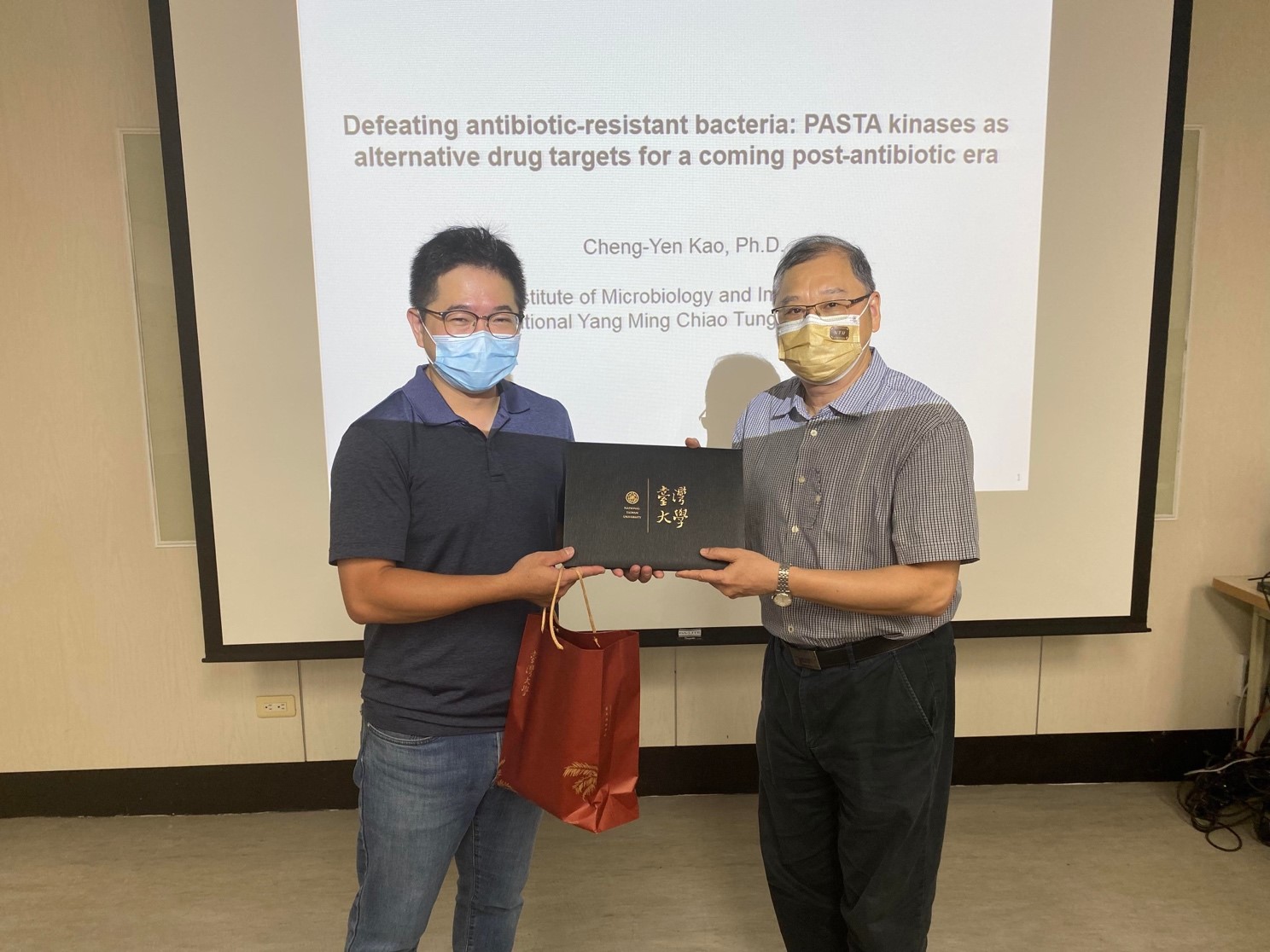
專題演講:
對抗抗藥性細菌:PASTA激酶可能為成為後抗生素時代的替代性藥物標的
在111年度上學期的第一周,葉光勝所長為分子暨比較病理生物學的師生安排了外賓講座,邀請到國立陽明交通大學微生物及免疫學研究所的高正彥助理教授,將主題聚焦在近年因應細菌抗藥性問題而生的相關研究。
細菌可透過多種機制形成抗藥性,像是形成水解抗生素的酵素(如β-lactamase)、改變細胞通透性、改變藥物的連接標的、增加藥物的排除,或是形成生物膜(Biofilm)等。人類從二十世紀初開發抗生素到西元1960年代抗生素蓬勃研發的黃金年代後,近幾十年內已經很少有新藥出現。研發新抗生素除了需要投入大量成本與時間,還可能因為細菌快速產生抗藥性而使心血付之一炬,如此龐大的風險也因此造成鮮少有公司願意加入藥物研發、臨床上可選擇的抗生素種類越來越少的窘境。而提到抗藥性,最惡名昭彰的便是對Methicillin具抗藥性之金黃色葡萄球菌(methicillin-resistant Staphylococcus aureus, MRSA),是一種對多種抗生素都有抗性、常見於社區或院內感染的菌株,其細菌表面的PASTA激酶(the penicillin-binding-protein and serine/threonine kinase-associated kinase)已知與細菌生物膜的形成、細胞壁的恆定、代謝及毒力相關,因此被科學家們視為抗生素機制的研究重點,若能透過相關基因的突變或阻斷其作用路徑去阻隔掉PASTA kinase的活性,是否就能扭轉細菌抗藥性生成的局勢?高正彥講師便分享了近年發現的PASTA kinase St1的抑制物,此藥物可以讓MRSA再次對β-lactam類抗生素產生敏感性,雖然目前在實驗中發現該藥物雖然具有抑菌作用,但同時也會造成細胞毒性,故仍待後續改良,但此機制的發現也為抗生素研發領域亮起一盞明燈,其未來的發展潛力令人期待。
感謝葉所長的安排與講師精彩的分享,讓本所師生更新了抗生素藥物的發展現況,也感受到在醫療進步的今日能有多種藥物可以使用,背後都是研究者們投入大量時間與心血的結晶。希望不久的將來能有更多抗生素相關研究開花結果,造福臨床上受抗藥性細菌所苦的醫師與病患!

On the first week of the new semester, Professor Kuang-Sheng Yeh invited Assistant Professor Cheng-Yen Kao from Institute of Microbiology & Immunology, National Yang Ming Chiao Tung University, to give us a speech on current research trends in antibiotic-resistant bacteria.
Many strategies against antibiotics in bacteria have been reported, including enzyme inactivation (e.g.β-lactamase), altering cell permeability, changing target binding sites, increasing antibiotic efflux, and formation of biofilm. There is little novel antibiotics that have been discovered after the golden age (1960s) of antibiotic development. Due to the vast amount of cost and time required for the investment, along with high risk of rapid rising of resistance to the novel antibiotic, pharmaceutical industries are less willing to invest in such project. Thus, there are fewer classes of antibiotics for clinical application recently. When it comes to antibiotic resistance, methicillin-resistant Staphylococcus aureus (MRSA) is resistant to many widely-utilized antibiotics and is commonly associated with nosocomial infection. It is reported that the penicillin-binding-proteins and Ser/Thr kinase-associated (PASTA) kinases, the transmembrane kinases that can be found on many Gram-positive pathogens, are related to biofilm formation, cell wall homeostasis, metabolism, and virulence. Therefore, PASTA kinases have been a potential target for stopping the emergence of antibiotic resistance. Recently, a PASTA kinase Stk1 inhibitor is identified through small-molecule screening and is reported to be able to dramatically increase the sensitivity to various β-lactams of MRSAthrough inhibition of the Stk1. Although some experimental condition requires further optimization, the proposed mechanism is a silver lining for the developing of antibiotics.
Besides getting an update on recent researches of antibiotics through the speech, we also realize that without the effort and time the investigators dedicated to this field. Hopefully, there will be more promising results coming up in the near future to benefit both clinicians and patients suffering from the rising of antibiotic resistance. Finally, thank Assistant Professor Kao for giving us an informative speech and Professor Yeh for arranging this seminar.
.jpg)

